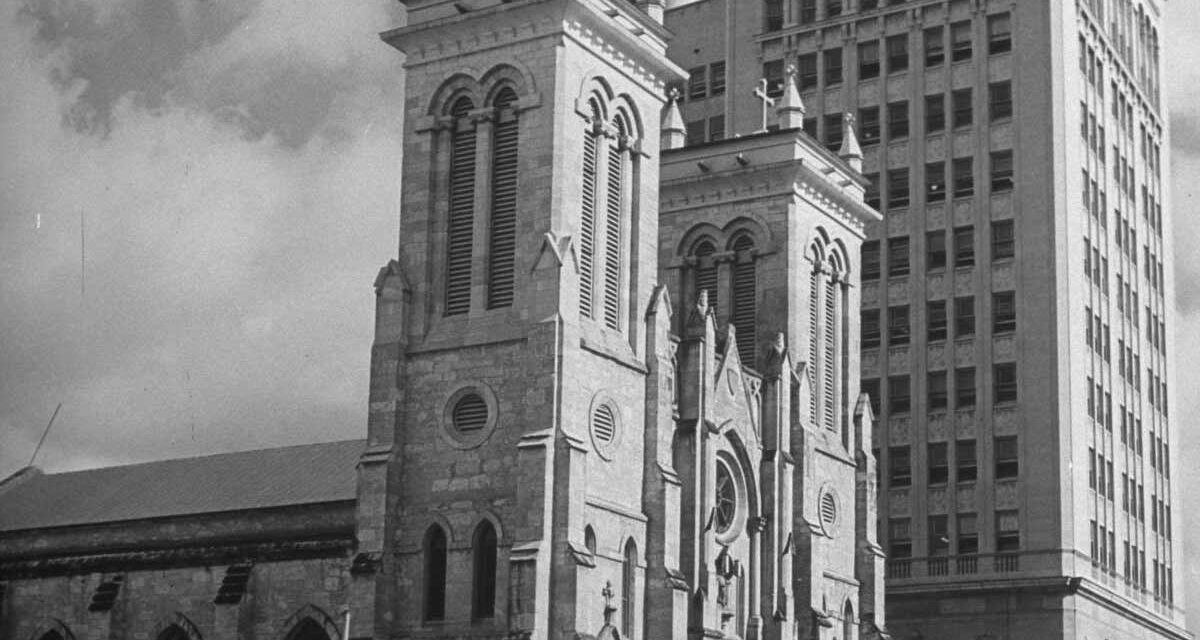In the mid 60’s Mom worked as a sales clerk at Rubin’s Outlet, in the “Mexican part of downtown”, at the corner of Houston & Flores, just a block away from San Fernando Cathedral. Rubin’s Outlet was very popular, the store featured Levis, Stetsons, Nunn Bush shoes and close out merchandise at bargain prices. Old timers remember the store as the former Buckhorn Saloon with the stuffed gorilla in the display window.
Every day for her half hour lunch break, Mom would always pay a visit to San Fernando Cathedral. Her Jewish boss would question Mom’s fellow employees, “Why does Carmelita always go to San Fernando to pray? What grievous sin has she committed to have to go to church so often?”
It was nothing like that, it was Mom’s deep faith in God and her saints, she would refer to them as her “heavenly lawyers”.
Many times I’d go with Mom to San Fernando. Right before we would enter the Cathedral, she would stop and piously put on her veil and if she did not have a veil she would find a handkerchief or a paper napkin to place over her head with a bobby pin. Her veil was her way to humble herself as she entered the House of God. At the holy water font she would bless herself and sprinkle my forehead with the sign of the cross.
Having to get back to work soon, she would hurriedly visit the statues of her heavenly lawyers… Jude Thaddeus, Anthony of Padua, Our Lady of Guadalupe and the Crucified Christ.
Before the statue of Our Lady of Guadalupe Mom would take out 30 cents in change and light 3 votive candles in the little red glass holders. She would always let me blow out the wax wick. Mom would kneel before Our Lady, look her straight in the eye and whisper prayers to her. Being so young I couldn’t figure out who this lady with flames shooting out from all sides was. Why was she so special to my mother?
I figure, with all the thousands of candles Mom had lit at San Fernando through the years, she owns stock in the Cathedral. Later in life, in talking to Mom I found out that those 3 candles were for my Dad, my brother Sonny and me.
At home we had a humble framed picture of Our Lady of Guadalupe on our wall. Mom would also whisper prayers to her. Mom taught me about Our Lady of Guadalupe as she fondly would refer to her “La Virgen Morena ” (the Brown Virgin). I learned about this “Brown Virgin ”, got to know her, pray to her, run to her and love her. She is now one my ‘heavenly lawyers“.Our Lady has her hands folded in prayer to show that there is someone much greater than her, she is pregnant, thus the patroness of the unborn. Practically every Mexican-American home has an icon of her. She has touched many families.
I learned about this “Brown Virgin”, got to know her, pray to her, run to her and love her. She is now one of my ‘heavenly lawyers”. I now share with you the story of Our Lady of Guadalupe that was given to me.
This beautiful story of the “Brown Virgin” was written by my late, great friend, Padre Harold Rahm, a Jesuit priest who I knew in El Paso, Texas. Fr. Rahm, S.J., requested that I share this story with everyone and let the story of “La Virgen Morena ” be known.
Her feast day is December 12th, as if you didn’t know! Happy feast day My Lady!
Herewith is Our Lady’s story…
La Virgen Morena
By Harold J. Rahm S.J.
Not quite four decades after Columbus discovered America and slightly more than one decade after the Spaniards first set foot on what is now Mexico, God in a special way showed His love for the peoples of the New World by sending them His Mother. And His Mother gave to the Americas a unique and wonderful gift; Her own self-portrait miraculously impressed upon the tilma of Juan Diego, a humble, unlettered Aztec Indian. Further, She promised Juan Diego that She would ‘give to you and all your people My merciful love” and expressed the desire that a Church be built on the spot where She appeared, so that “She might show compassion to all who are devoted to Me and seek Me in their need.” And this took place at a time when no boundary lines were yet drawn across the Americas— hence Her words for all the peoples of the New World.
Her portrait, the miraculous painting of Our Lady of Guadalupe (for so She stated She wished to be known when She appeared to Juan Diego’s dying uncle, Juan Bernardino) hangs high over the Altar of the Basilica of Our Lady of Guadalupe in Mexico City—an inspiration to all who behold it, a source of comfort and hope to all who invoke Her aid. Her compassionate partly-downcast eyes and loving hands joined in prayer teach us by example the value She places on prayer and that there is someone greater than Her.
To this Basilica of Our Lady of Guadalupe in Mexico City, millions come annually. They come by car, by train, by plane and many on foot– from all corners of the country and from faraway lands beyond Mexico’s borders. They come to see the portrait, to ask Our Lady’s special intercession, to thank Her for the graces received.
The portrait itself has confounded art experts through the centuries who have examined it minutely. By all natural laws the tilma a coarsely-woven cloak of cactus fiber, should long ago have disintegrated, especially since for over a century it hung in the open, whereas now it is covered with glass. No art expert has ever been able to explain the method of application of the media used for impressing the portrait on the tilma. No other painting known to exist has the natural life-like quality of the portrait of Our Lady of Guadalupe– and certainly nothing comparable to it was known or is available dating back to the early part of the 16th century. Moreover, of a group of five opthamologists who examined the eyes of the portrait through their ophthalmoscopes in May of 1956, each found he was “looking into a human eye” (this is authenticated by a certificate dated May 26, 1956, signed by five).
This portrait was left to us by Our Lady in the year 1531. By the end of 1531, the Spaniards had a decade of conquest of the Indians behind them but, unfortunately, the leaders had become ruthless in their quenchless thirst for wealth and power and the Aztecs had discovered the Spaniards were not gods but only human beings as they and had become very restless under their yoke of oppression; all of which did not tend to make them take kindly to the religion the Spaniards sought to spread.
But fortunately , just shortly before, the Spanish Crown had sent Bishop-elect Juan de Zumarraga, O.F.M, to represent the Church and Fray Zumarraga, a holy and just man, was concerned greatly about the behavior of the spread of Christianity among the newly-found peoples. Upon his arrival in the Tenochtitlan, where the Spaniards had set up their seat of government upon the ruins of the principal city of the Aztecs, he built his Cathedral in honor of the “Mother of God” and expressed the wish to concentrate the lands of the New World to her. (Incidentally, the United States of America was consecrated to the Immaculate Conception in 1846.) Fray Zumarraga prayed fervently to the Immaculate Conception of Our Lady to help him find a solution to the threat posed by the Aztecs whom he sensed were ready to revolt against and destroy the Spaniards and for a way to win them in great numbers to the Christian religion and way of life.
Our Lady’s answer to his prayers came so simply and beautifully and was so quietly accomplished, that historical writings make little mention of it as a moment which changed American history. yet Our Lady’s gentle touch did just that.
Her answer was delivered through Juan Diego, an Aztec Indian, who with his wife Maria and uncle Juan Bernardino, had been among the very first few new world converts to Christianity.
Early on the morning of December 9, 1531, as Juan Diego was walking from his home to the Franciscan monastery at Tlatelolco, some miles distant to attend Mass in honor of the Conception of Mary celebrated on the 9th, She appeared to him in this wise:
As he was passing the rocky crags of Tepeyac hill, he was brought to his knees by a dazzling light and the sound of ethereal music. He looked up to see a beautiful Lady smiling tenderly and lovingly at him.
The Lady called him by name and addressing him in his own Nahuatl language told him: “I want you to know, my son, that I am the ever Virgin Mary, Mother of the true God, Author of life, Creator of all things, Lord of heaven and earth, Who is everywhere. I urgently desire that a Church be built here on this site where I may give to you and all your people My merciful love and may show My compassion to all who are devoted to Me and seek Me in their need. Go to the house of the bishop in Mexico and tell him all that I have told you. Tell him of My desire for a Church to be built on this site in My honor.”
When Juan presented his claim that he carried a message from the Mother of god, Fray Zumarraga listened patiently to his story and then dismissed him. Juan felt that the bishop did not believe him.
Discouraged, he returned to the hill where the music and the radiant light proclaimed the Lady’s presence. He found Her waiting for him there and knelt at her feet, addressing Her in these touching words: “My very dear Daughter, my Queen, my Lady Most High, I did what You asked… I do not think he believed me, because he told me to come back again, so that the Church which You asked ask to be built is a fiction of mine, or a fancy of mine, and not your will: and so I pray You, that You send some noble and chief person for this purpose, one worthy of respect and to whom credence will be given; because you see my Mistress, that I am a poor country man, a humble villager, and this matter on which Your indignation or to have displeased you with my reply.” She assured him that She had chosen him above all others to be her messenger and told Juan to return to the bishop on the morrow and repeat Her request.
True to his promise, Juan visited the bishop’s house the next day and repeated the story. The bishop listened more attentively as each detail was reaffirmed by the Indian. Finally, the bishop asked Juan to being some sign as proof of the story, and Juan happily agreed to do so.
As the Indian left, the curious bishop assigned two servants to follow him and report on what they saw. However, as they approached Tepeyac hill, Juan disappeared from their sight. they turned back, disgusted, and gave the bishop an unfavorable report.
Our Lady now told Juan Diego that She would give him a sign for the bishop on the following morning. He left with joy in his heart, but was upset upon returning home to find that his uncle, Juan Bernardino, was very ill and required constant attention throughout the day. The morning of December 12, Juan Diego set out to bring a priest to his uncle’s bedside as the old man was convinced that death was near and wanted to receive the Last Sacraments.
As he approached Tepeyac, Juan reasoned that he could take a different path and avoid the Lady. Surely She would be angry with him for failing to keep his appointment the day before. Well aware of his feelings the Lady met him on the path and comforted him. Juan requested her permission to let him continue on his way for his uncle was very ill.
“Listen, My son, to what I tell you now. Do not be troubled, nor disturbed by anything; do not fear illness, nor any grievous happening nor pain. Are you not under My shadow, My protection? And am I not life and health? Are you not in My favor, and do you not go on My errand. Do you need anything else? Do not be troubled, or take thought of your uncle’s illness, for he will not die of this seizure and is well now.” (And it was so, as he learned later on, according as She had said.)
And She continued, “Go now to the top of the hill and there you will find roses blooming. Pick as many as you can hold in your cloak and bring them to me.”
Flowers had never before been seen on this rocky point where only cactus could thrive. Trusting the lady, however, Juan ascended to the rocky summit.
There he found beautiful, fragrant roses, the like of which he had never seen before, blooming in profusion. Juan gathered as many roses as he could and placed them in his tilma. Descending, he returned to the Lady who arranged the flowers carefully in his cloak and bade him return to the bishop. His heart singing, Juan hastened to the bishop’s house, clutching the roses in his tilma.
Once in the presence of the bishop, Juan Diego opened his tilma to reveal the roses, unaware that Fray Zumarraga had been praying for just such a sign. But at the very instant the roses dropped to the floor, Fray Zumarraga witnessed the appearance of the Image of Our Lady on the cloth. Falling to his knees, he thanked God for this heavenly gift.
In the meantime, the old uncle, Juan Bernardino, also had received a visit from the Lady, who instantaneously restored him to health. Thus cured, She gave him the message that She wished to called, “Santa Maria de Guadalupe.” This name, as spoken by the old man in his native tongue, more than likely was the Indian phrase meaning “She who crushed the head of the serpent.” This sound was interpreted by the Spaniards to be “Guadalupe” the name of a well known shrine to Our Lady in Spain.
In truth, Our Lady did “crush the serpent,” for the Indians, whose religion had many gods and goddesses of all shapes and attributes, likewise revered the feathered serpent. Now they accepted the God of the Spaniards as they flocked to the shrine built to house the Holy Image.
Through this intervention of Our Lady of Guadalupe, eight million Indians were converted in the next seven years. For to the Indians, who had no alphabet of their own, the message of the visions and the symbolism of Our Lady’s portrait as interpreted by them had tremendous significance, and it brought them by the myriads into the Church, many of them traveling great distances for the purpose.
With Our Lady’s help the Spaniards remained to colonize Mexico and to extend the teachings of the Church in America. Without Her help the Spaniards, they might have vanished from Mexico and American history might have followed a vastly different course.
To the Indians, She is the beloved “Dark Virgin.” To all the Americas— North, South and Central— She is the Mother of God.
Whatever may be the correct interpretation of Her name and Her appearance, it is certain that once you see Our Lady of Guadalupe, you will never forget Her. She is an inspiration to all to try to live up to the wonderful love of God, who blessed the Americas through this precious gift. In truth, She is The Mother of the Americas.
¡Viva La Virgen Morena!
Rick Melendrez, is a native San Antonian. Melendrez considers himself fortunate to have been born in San Antonio, just 3 blocks from the San Antonio de Valero mission (the Alamo) at the former Nix hospital on the riverwalk and to have attended Catholic grade school on the southside and on the river walk.
Catholic education is very close to his heart. Melendrez attended St. Michaels for five years (1960-65) and then attended St. Mary’s School on the river walk (1965-68) and onto Cathedral high school in El Paso, Texas.
He is the former publisher of the El Paso Citizen newspaper and former chairman of the El Paso County Democratic Party. He writes a page on Facebook titled “Sister Mary Ruler, Growing Up Catholic In San Antonio”. Everyone is invited to read about the San Antonio of the 1960’s












